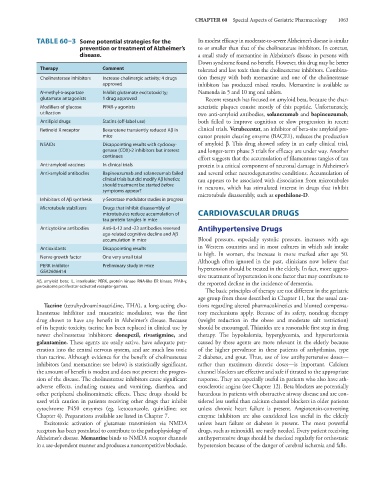Page 1077 - Basic _ Clinical Pharmacology ( PDFDrive )
P. 1077
CHAPTER 60 Special Aspects of Geriatric Pharmacology 1063
TABLE 60–3 Some potential strategies for the Its modest efficacy in moderate-to-severe Alzheimer’s disease is similar
prevention or treatment of Alzheimer’s to or smaller than that of the cholinesterase inhibitors. In contrast,
disease. a small study of memantine in Alzheimer’s disease in persons with
Down syndrome found no benefit. However, this drug may be better
Therapy Comment tolerated and less toxic than the cholinesterase inhibitors. Combina-
Cholinesterase inhibitors Increase cholinergic activity; 4 drugs tion therapy with both memantine and one of the cholinesterase
approved inhibitors has produced mixed results. Memantine is available as
N-methyl-d-aspartate Inhibit glutamate excitotoxicity; Namenda in 5 and 10 mg oral tablets.
glutamate antagonists 1 drug approved Recent research has focused on amyloid beta, because the char-
Modifiers of glucose PPAR-γ agonists acteristic plaques consist mostly of this peptide. Unfortunately,
utilization two anti-amyloid antibodies, solanezumab and bapineuzumab,
Antilipid drugs Statins (off-label use) both failed to improve cognition or slow progression in recent
Retinoid X receptor Bexarotene transiently reduced Aβ in clinical trials. Verubecestat, an inhibitor of beta-site amyloid pre-
mice cursor protein cleaving enzyme (BACE1), reduces the production
NSAIDs Disappointing results with cyclooxy- of amyloid β. This drug showed safety in an early clinical trial,
genase (COX)-2 inhibitors but interest and longer-term phase 3 trials for efficacy are under way. Another
continues effort suggests that the accumulation of filamentous tangles of tau
Anti-amyloid vaccines In clinical trials protein is a critical component of neuronal damage in Alzheimer’s
Anti-amyloid antibodies Bapineuzumab and solanezumab failed and several other neurodegenerative conditions. Accumulation of
clinical trials but did modify Aβ kinetics; tau appears to be associated with dissociation from microtubules
should treatment be started before in neurons, which has stimulated interest in drugs that inhibit
symptoms appear?
microtubule disassembly, such as epothilone-D.
Inhibitors of Aβ synthesis γ-Secretase modulator studies in progress
Microtubule stabilizers Drugs that inhibit disassembly of
microtubules reduce accumulation of CARDIOVASCULAR DRUGS
tau protein tangles in mice
Anticytokine antibodies Anti-IL-12 and -23 antibodies reversed Antihypertensive Drugs
age-related cognitive decline and Aβ
accumulation in mice Blood pressure, especially systolic pressure, increases with age
Antioxidants Disappointing results in Western countries and in most cultures in which salt intake
is high. In women, the increase is more marked after age 50.
Nerve growth factor One very small trial
Although often ignored in the past, clinicians now believe that
PERK inhibitor Preliminary study in mice hypertension should be treated in the elderly. In fact, more aggres-
GSK2606414
sive treatment of hypertension is one factor that may contribute to
Aβ, amyloid beta; IL, interleukin; PERK, protein kinase RNA-like ER kinase; PPAR-γ, the reported decline in the incidence of dementia.
peroxisome proliferator-activated receptor-gamma.
The basic principles of therapy are not different in the geriatric
age group from those described in Chapter 11, but the usual cau-
Tacrine (tetrahydroaminoacridine, THA), a long-acting cho- tions regarding altered pharmacokinetics and blunted compensa-
linesterase inhibitor and muscarinic modulator, was the first tory mechanisms apply. Because of its safety, nondrug therapy
drug shown to have any benefit in Alzheimer’s disease. Because (weight reduction in the obese and moderate salt restriction)
of its hepatic toxicity, tacrine has been replaced in clinical use by should be encouraged. Thiazides are a reasonable first step in drug
newer cholinesterase inhibitors: donepezil, rivastigmine, and therapy. The hypokalemia, hyperglycemia, and hyperuricemia
galantamine. These agents are orally active, have adequate pen- caused by these agents are more relevant in the elderly because
etration into the central nervous system, and are much less toxic of the higher prevalence in these patients of arrhythmias, type
than tacrine. Although evidence for the benefit of cholinesterase 2 diabetes, and gout. Thus, use of low antihypertensive doses—
inhibitors (and memantine; see below) is statistically significant, rather than maximum diuretic doses—is important. Calcium
the amount of benefit is modest and does not prevent the progres- channel blockers are effective and safe if titrated to the appropriate
sion of the disease. The cholinesterase inhibitors cause significant response. They are especially useful in patients who also have ath-
adverse effects, including nausea and vomiting, diarrhea, and erosclerotic angina (see Chapter 12). Beta blockers are potentially
other peripheral cholinomimetic effects. These drugs should be hazardous in patients with obstructive airway disease and are con-
used with caution in patients receiving other drugs that inhibit sidered less useful than calcium channel blockers in older patients
cytochrome P450 enzymes (eg, ketoconazole, quinidine; see unless chronic heart failure is present. Angiotensin-converting
Chapter 4). Preparations available are listed in Chapter 7. enzyme inhibitors are also considered less useful in the elderly
Excitotoxic activation of glutamate transmission via NMDA unless heart failure or diabetes is present. The most powerful
receptors has been postulated to contribute to the pathophysiology of drugs, such as minoxidil, are rarely needed. Every patient receiving
Alzheimer’s disease. Memantine binds to NMDA receptor channels antihypertensive drugs should be checked regularly for orthostatic
in a use-dependent manner and produces a noncompetitive blockade. hypotension because of the danger of cerebral ischemia and falls.

